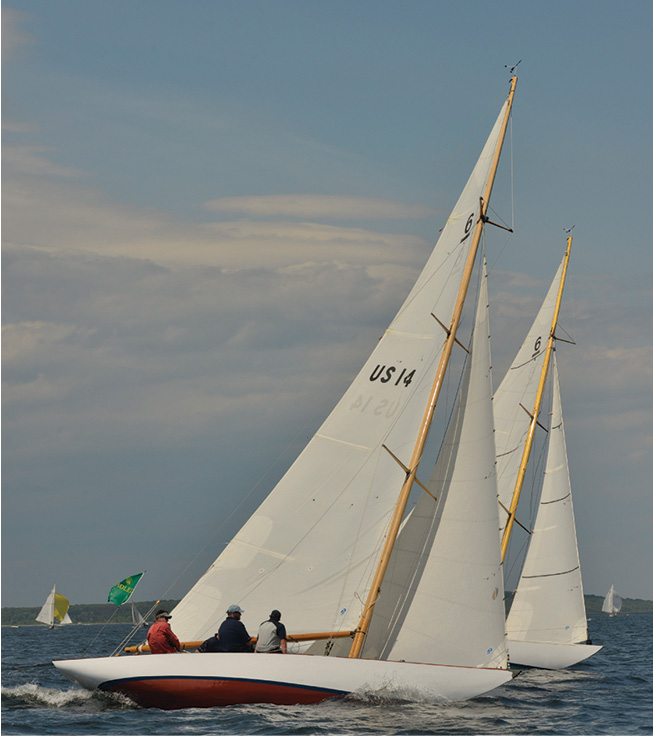By David Dellenbaugh
“Why didn’t you cover?” is often the first question you hear when you were doing well in a race but got passed by one or more boats from behind. This is a great question, but it doesn’t always have a straightforward answer.
“Covering” usually means staying between the next mark and one or more boats that are behind you. The goal of this tactic is simply to reduce your risk if the wind shifts (or another variable changes), and thereby increase your chances of staying in front of the boat(s) behind you. While covering boats behind is usually a fairly sound idea, there is no rule that says you have to do it. In fact, the decision of whether or not to cover is often fairly complex. Perhaps the most critical factor to consider is your goal in the race: In simple terms, are you trying to stay ahead of the boats behind you, or to catch the boats in front of you?

Some people think that covering means you have to tack to windward and ahead of another boat so you slow them with your wind shadow. But usually they will just tack away to keep their air clear. One option is to tack in a position that’s between a tight and loose cover, with your wind shadow hitting the mainsail of the boat to leeward. By doing this, you allow the other boat to keep her air clear by footing instead of tacking. If she chooses this option, you will gain fairly tight control as well as distance to windward. © Allen Clark/PhotoBoat.com
Are you happy?
When I’m deciding whether or not to cover, I ask myself one simple question: Am I happy with my position in the race at this moment? If my answer is yes, then my primary goal is to protect what I have. And covering the boats behind is usually a good way to accomplish this.
When I’m not happy with my position in the race, then my main goal is to improve my standing in the fleet, not just maintain it. My tactics are geared toward catching the boats ahead rather than covering the boats behind.
When you’re in first place, this choice is easy: there are no boats to catch so your only goal is to stay ahead of the boats behind. Being in last place is also pretty straightforward, but everywhere in between you have a choice: you can cover (look behind, be conservative, guard what you have) or attack (look forward, take risks, improve your place).
To hurt or herd?
When covering another boat, are you trying to get farther ahead of them, or just keep them from passing you? Both are possible, but it’s difficult to hurt another boat with your wind shadow because they can simply tack away. This works only when you have them trapped in a position where they have to keep going in the same direction (e.g. they’re on the layline).
Usually your wind shadow is much more effective as a blocking tool to ‘herd’ the other boat(s) in the direction you want. For example, you can make another boat go left by placing your bad air just to their right. Many sailors think that if you want to stay close to a boat behind you should tack on them in a tight covering position. But ironically, this usually has the opposite effect since they will just tack and start sailing away from you.
When you’d be foolish to cover
When your main goal is to stay ahead of the boats behind you, it’s usually a good idea to cover them. But one time you might not want to cover too closely is when you are sailing in oscillating winds.
In shifty conditions, your first priority should be to sail your own race. Covering can actually hurt you if you don’t play the windshifts correctly. For example, if you’re crossing another boat and you’re on a lift, you certainly wouldn’t want to tack to “cover” them because then you’d be on a header and they’d tack onto the lift. When it’s shifty, you need to have courage. If you’re sure about the windshifts, play them and forget about the other boat(s); when you’re not sure, use a loose cover.
When you’re not ahead
The corollary of ‘cover when ahead’ is ‘avoid cover when behind.’ You won’t pass other boats by following them, so try to split the other way. Of course, this tactic depends on your goal in the race. If you still have a long way to go before the finish, or if you’re worried about the boats behind, or if one side of the course is obviously favored, you may want to keep following your ideal strategic gameplan, even if this means you have little chance to gain on the boats that are covering you. In the long run, playing the odds and staying “in touch” may be your best tactic. ■
This article originally appeared in David Dellenbaugh’s Speed & Smarts, The newsletter of how-to tips for racing sailors. If you want to sail faster and smarter, log onto SpeedandSmarts.com.
A resident of Easton, CT, Dellenbaugh was tactician and starting helmsman for America3’s successful defense of the America’s Cup in 1992. He’s a Lightning World Champion, two-time Congressional Cup winner, seven-time Thistle National Champion, two-time winner of the Canada’s Cup, three-time Prince of Wales U.S. Match Racing Champion, and a winner of the U.S. Team Racing Championships for the Hinman Trophy.
